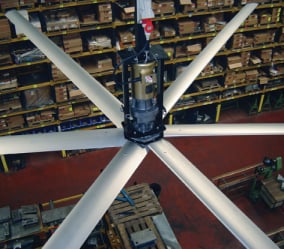Why Is It Difficult to Cool a Facility with High Ceilings? High ceiling air circulation in...
The Simple Way to Improve Warehouse Cooling Efficiency
Manufacturing facilities and other large warehouse environments have a variety of unique maintenance challenges such as air quality, energy costs, safety and comfort, and temperature control. With MacroAir’s high volume, low speed (HVLS) fans strategically installed to compliment HVAC systems, employees’ health and safety are improved, and significant energy is saved due to increased efficiency.
Benefits

There are many benefits to utilizing HVLS fans around the warehouse including improvement in employee health and comfort, elimination of pollution and stale air buildup, ability to cool large spaces, and lower energy costs.
-
Improvement in Employee Health and Comfort
During hot summer months, MacroAir HVLS fans create a gentle breeze throughout the facility that keeps employees cool through quicker sweat evaporation. Simultaneously, air quality is improved due to better ventilation.
Two common air quality issues faced by employees are Sweating Slab Syndrome (SSS) and Sick Building Syndrome (SBS). SSS occurs as a result of intermittent moisture developing on the surface of concrete slabs. This can result in slippery floors that pose a serious safety risk. However, with proper air movement through the building, moisture will evaporate more quickly. SBS is the result of time spent in a building and exposure to airborne building contaminants. Those infected experience headaches, dizziness, and nausea that disappear after they leave the building. SBS is caused by stagnant air due to poor building design, lack of maintenance, and poor ventilation.
-
Elimination of Pollution and Stale Air Buildup
Poor ventilation systems can result in pollutant buildup within the warehouse. Therefore, the air quality of the indoor environment can become worse than the air outside. Poor ventilation design and humidity are the primary culprits of pollutant backup. However, the air movement produced by HVLS fans provides drastic relief and does not allow the air to settle and pollutants to pile up.
-
Ability to Cover Large-Scale Buildings
Many modern HVLS fans can move large volumes of air. One fan can cover up to 22,000 square feet and hold the same effectiveness as 20-floor fans. Since the typical size of an HVLS fan is 24 feet in diameter, the blades are designed to maximize the amount of air captured and push it to the floor. In the summer, this circulates the cool air created by an HVAC system. In the winter, destratification occurs. This is when the HVLS fans, run in reverse, capture the higher warm air created by an HVAC system and push it down to the floor, improving comfort levels. This reduces energy consumption by up to 30 percent!
-
Lower Energy Costs
MacroAir’s energy-efficient HVLS fans only use 1,500 watts per hour to cool and as little as 100 watts per hour for destratification, resulting in significantly lower energy costs.
When used with air conditioning, the fans lower the overall temperature allowing building maintenance to increase the thermostat. As a result, energy costs are reduced by 4 percent for every degree increase.
Since the energy usage is extremely low to operate the fans, they can help achieve LEED certification by points in applicable credit categories. One common LEED strategy is to eliminate the need for refrigerant-based comfort systems. During moderate climates, HVLS fans can significantly minimize or, in some instances, eliminate reliance on these other comfort systems. HVLS fans can help projects earn points in the following LEED credits categories:
- Energy & Atmosphere
- Indoor Environmental Quality
- Innovation in Design
With so many benefits, HVLS fans should be used in all warehouses. They save on energy costs and consumption, eliminate pollutant backup, can cover a wide area, and most importantly, create a more comfortable working environment for employees. Check out the MacroAir Fan Calculator to identify the best fan for your application and to see how much money and energy you can save.
